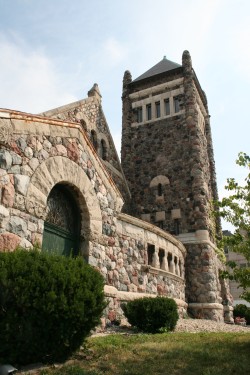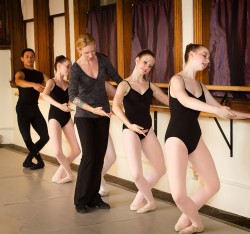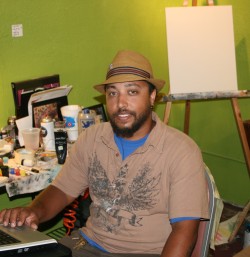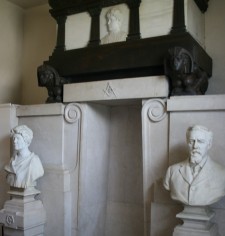Standing tall on its perch overlooking I-74, the castle-like structure at Madison and Spalding cuts an imposing presence. With its shapely pillars of cut stone, ornate windows of stained glass, and archways and turrets that recall a long-lost sense of craftsmanship, the Cornerstone Building is a window into another era, a magical place that’s not easily forgotten.
Having long been a popular site for weddings and banquets, it’s now an emerging arts center. Anchored by a ballet academy that opened earlier this year, the building also features a music café and an array of artists and craftsmen working on the lower level. A featured stop on CIAO’s First Fridays art walk, this beautiful building—long underutilized—is being reclaimed as a haven for creativity.
Laying the Foundation
The Cornerstone Performing Arts Academy, housed on the second floor, offers classes in classical ballet and other dance styles, as well as yoga, taekwondo and more. Led by Jennifer Reiter, academy director, and Rebekah von Rathonyi, artistic director, it launched in a building that shares its name, but surprisingly, this was unplanned—simply a happy accident.
“We actually came up with the name… before we even knew about the building,” exclaims Reiter, her eyes lighting up at the coincidence. The name was suggested by one of their students’ parents, who was inspired by the word cornerstone during a sermon at church. Eventually, the search for a location led them to the Cornerstone Building, which happened to offer everything they needed, and then some. “An act of God,” Reiter calls it.
Upon touring the building, it was love at first sight. “Our brains were just going crazy!” von Rathonyi exclaims. “There’s so much you can do here that you couldn’t do in a normal studio. Not only can we teach classes, there’s a café downstairs… We can have in-house performances in the banquet room… It’s up close and personal, and you can do so much with the room in terms of staging and lighting.”
Indeed, the building itself has been an inspiration for all involved. “In the process of opening the ballet, I just fell in love with it,” says Karen Cassidy, one of the volunteers who got the academy up and running. Now its business manager, Cassidy also manages the Cornerstone Underground Art Venue, which encompasses the café and 10 studios in the basement.
“When I came, there was just one artist here,” she recalls. Sensing unfulfilled possibilities, she asked Verne and Ann Dentino, the building’s owners, about their plans for the space. “They had a vision for an arts center. I started putting the word out, and [the response] was just crazy… Between the ballet, the music venue, and all the artist studios, it’s really becoming what they want it to be.”
 The Passing Hands of Time
The Passing Hands of Time
Reflecting the Richardson Romanesque Revival style of the late 19th century, the 12,000-square-foot structure was designed by W.W. Boyington, well known as the designer of the Water Tower in Chicago. Originally built to house the Second Presbyterian Church, the structure was completed in 1889. That year, a cornerstone containing a copper box with photos and documents was placed in the building’s southwest corner to mark the 100th anniversary of the inauguration of President George Washington.
In 1949, the Electra Chapter of the Eastern Star, a Masonic organization, purchased the building from the First Federated Church, which formed out of the merger of the Second Presbyterian and First Congregational churches. Twenty years later, it was nearly torn down to make way for a gas station, but plans to sell the property to Shell Oil were scuttled by strong public opposition.
The building sat vacant for many years. Various plans to house a dinner theater or a medieval restaurant were floated, but never came to fruition. In 1987, a businessman named William Haas purchased the building, renamed it the “Cornerstone,” and turned it into a banquet facility, a role it has served off and on under various owners ever since.
In 2009, local attorney Verne Dentino and his wife Ann purchased the Cornerstone Building. Longtime supporters of the arts, the Dentinos are now extending that commitment by transforming it into an arts and cultural center in the heart of downtown Peoria.
Ballet in the Blood
When Rebekah von Rathonyi and Jennifer Reiter left the Peoria Ballet last year, neither was sure what the future held. “I wasn’t interested in starting a studio,” says von Rathonyi, “and maybe not even going back into ballet.” She considered nursing, but instead took a few months off. “I was burned out. I needed to look at my life and see what was best.”
That brief respite was all she needed to recharge her passion. “All of a sudden, it made sense… [Ballet] is my life—I’d been doing it for 25 years,” says von Rathonyi. “It’s in my blood, and there’s no getting rid of it.” With that in mind, the two friends brainstormed with some of their students’ parents, and soon, there were plans for an academy, then a name, and finally, a physical location. But the space needed some work.
 “When we first came, the studio was storage… filled with furniture, some extra plywood and a lot of dust!” recalls Reiter. “Our volunteers cleaned it all out, put a fresh coat of paint on the walls, and completely renovated it.”
“When we first came, the studio was storage… filled with furniture, some extra plywood and a lot of dust!” recalls Reiter. “Our volunteers cleaned it all out, put a fresh coat of paint on the walls, and completely renovated it.”
Since opening in January, the academy has steadily expanded, with classes for all ages and skill levels, and offerings that extend far beyond classical ballet. Dancers today have to be very diverse, Reiter explains. “They have to not only be able to do classical ballet, but also contemporary [ballet], hip hop, tap, jazz, musical theater… We’re giving our students a very well-rounded education.”
“Our taekwondo program is starting to really blossom,” she continues. “We also have a relationship with the gang over at City Dance [Peoria’s new hip hop dance organization]… Our kids just love that.”
Live performance, adds von Rathonyi, is also critical. Since its opening, Cornerstone students have performed nearly three dozen times—at retirement homes, libraries, schools and churches. “It’s such a great education,” she says. “You never know what sort of performance space you’re going to walk into, what the audience will be like, what the sound equipment is going to do. It forces them to really focus… It’s a wonderful thing—how much they get to perform.”
Back to the Underground
Meanwhile, as Cassidy helped get the academy off the ground, she began fleshing out Dentino’s vision for an arts center. Downstairs in the Cornerstone Underground Art Venue, she’s rented studios to a diverse group of artists and craftspeople. “What the artists turn them into is phenomenal,” Cassidy says, bubbling with excitement.
 On one side of the Underground space, Jenny Foster designs vintage clothing and creates mixed media and fiber art out of a space she calls The Vintage Bunker. Travis and Tesa Baillie, a husband-and-wife photography team, specialize in weddings and senior pictures. Angie Stiles Richardson forges sterling silver jewelry under the name MetalME, while painter Keith Wilson works with spray paint, mixed media and more at Kreative Worx.
On one side of the Underground space, Jenny Foster designs vintage clothing and creates mixed media and fiber art out of a space she calls The Vintage Bunker. Travis and Tesa Baillie, a husband-and-wife photography team, specialize in weddings and senior pictures. Angie Stiles Richardson forges sterling silver jewelry under the name MetalME, while painter Keith Wilson works with spray paint, mixed media and more at Kreative Worx.
The other side of the Underground is being turned into a “pampering” area. Felicha Brown, who makes hand-poured candles, soap and lotions as True Royalty Scents, “just fell in love with it,” says Cassidy. “She could see the possibilities. That’s who we want—the people who see the possibilities and really want to be here.” Brown will soon be joined by several salons and an esthetician who will offer facials and other skin care treatment.
Sandwiched between the “art” and “pampering” sides of the Underground is the café—a large, open room that’s been transformed into a venue for live music and events. “I was… trying to figure out what this area could be used for. I liked the idea of music down here… and it has that coffee-shop atmosphere.”
An open mic night at the café in February led to the first “Indie on the Corner” event later in the spring. Now a monthly feature, it highlights live music from local independent acts. The café has hosted a book signing and several CD release parties, and Cassidy is working to create a monthly jazz night. The Underground is also a destination on CIAO’s First Fridays tour.
A Shared Vision
Reiter and von Rathonyi are a close-knit team, so close they practically finish each other’s sentences. And not only do they get along, their skillsets are very complementary. “I have a background in musical theater and modern dance, and come from the academic side,” says Reiter. “Rebekah comes from the classical ballet side. She’s done company work and performed professionally in many places. So we bring different things to the table.”
Even more importantly, they share a vision for the academy. “We discovered pretty early that our teaching philosophies and general ideas about how a ballet school should be run were very common,” Reiter continues. “We also share ideas when it comes to technique.”
Safety and an individualized approach to each student are key. “A lot of kids can be pushed too soon to do things their bodies aren’t ready for,” says Reiter. “We’re on the same page with where those landmarks are. It’s very important to us that the dancers are safe in all aspects.”
“Every student needs something different,” von Rathonyi adds. “We can cater to each individual and what they need personally. We don’t want anyone to fall through the cracks. We also believe that children shouldn’t be kept from the arts for financial reasons. In fact, 70 percent of our students are on a full scholarship. We offer not only financial scholarships, but merit and talent scholarships.”
Reiter is quick to point out that what’s learned in the studio is valuable outside of it as well, whether or not the student becomes a professional dancer. “Ballet teaches so many things,” she says. “What people notice most are the discipline and the personal responsibility it requires. But in terms of mental development—having to think about what your body is doing as an entire unit… thinking about the choreography… listening to the music—it’s so good for developing brains.”
“And then you have the expression side,” adds von Rathonyi. “Every night, these young people have an opportunity to express different emotions and find out what they connect to in terms of the arts… It helps them discover who they are… and that’s really exciting to see. Plus, they can come here and just be themselves. If they had a bad day at school or got into a fight with their brother and sister, they know they can come here and just do what they love to do.”
Building Inspiration
After being underutilized for so many years, this beautiful, historic building is now a hub of activity, as its current owner intended. And with the contagious enthusiasm of Cassidy, Reiter and von Rathonyi, it seems likely to remain that way for some time to come.
“I have tons of ideas!” exclaims Cassidy. “Right now, we’re almost maxed out in terms of space, but I would like to see the café used for whatever people can think of. The possibilities down here are pretty endless, and a lot of people don’t know it’s here. That’s been my next step: getting the word out.”
In the meantime, the ballet academy continues to expand, both in enrollment and its offerings. “Right now, we’re just focusing on the students and building the school… taking everything one day at a time,” says von Rathonyi. It’s been a long journey, but a satisfying one, and it’s unfolding in one of the most unique locations in all of Peoria.
“It’s a very inspiring place,” says Reiter. “The building, its presence—it’s inspiring just to pull into the driveway each day.” a&s



